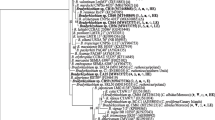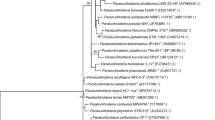Abstract
Lupinus, known by the common name of lupine or lupin, is a highly diverse genus of legume and is one of the most geographically widespread plant genera. Lupines can develop indeterminate nodules, known as lupinoid-nodules, in association with rhizobia, mainly belonging to the Bradyrhizobium genus. In this work, diversity of Uruguayan native rhizobia obtained from nodules of native Lupinus species growing in their natural habitat, was evaluated. We generated a collection of 109 isolates obtained from nodules of six, out of the seven, Uruguayan native species of lupine described for Uruguay: Lupinus albescens, Lupinus bracteolaris, Lupinus gibertianus, Lupinus lanatus, Lupinus multiflorus and Lupinus paraguariensis. According to the phylogeny of the 16 S rRNA gene, isolates belong to six well defined clusters within the Bradyrhizobium genus. Four of these clades include Bradyrhizobium species already known to be capable of nodulating Lupinus spp., while two clades include Bradyrhizobium species that have not been previously described as lupine nodule endosymbiont. Phylogeny of nifH and nodC genes was investigated in 21 selected isolates obtained from different lupine species and from different sites of collection. Our results indicate that the diversity of symbiotic genes is related to the continental origin of the lupine species rather than to the conserved 16 S rRNA molecular marker. Also interesting was the fact that symbiotic genes of rhizobia that nodulate the same native lupine species may have different evolutionary history. In conclusion, our results expand the knowledge about the phylogenetic diversity of Bradyrhizobium strains nodulating lupine species and provide insights in the biogeographic coevolution between lupines and its cognate rhizobia. Results obtained, together with the fact that the role of Nod factors in the recognition of lupine plant species by rhizobia has not yet been demonstrated, let us to hypothesize that nodC may be required for the development of a nitrogen-fixing nodule, but not for host plant recognition in the lupine-rhizobia association. Our results reinforce the hypothesis of a recent acquisition and evolution of symbiotic genes nifH and nodC in bacteria nodulating lupines.






Similar content being viewed by others
Data Availability
The datasets supporting the conclusions of this article are included in the manuscript and Additional files.
References
1https://powo.science.kew.org/. Plants of the World Online | Kew Science
Abraham EM, Ganopoulos I, Madesis P, Mavromatis A, Mylona P, Nianiou-Obeidat I, Parissi Z, Polidoros A, Tani E, Vlachostergios D (2019) The Use of Lupin as a source of protein in animal feeding: genomic tools and breeding approaches. Int J Mol Sci 20(4). https://doi.org/10.3390/IJMS20040851
Alonso Paz E (1991) El Género Lupinus (Leguminosae, Papilionoideae) en el Uruguay. Comun Botánicas del Mus Hist nat. Montevideo 97:1–15
Andrews M, Andrews ME (2017) Specificity in Legume-Rhizobia Symbioses. Int J Mol Sci MDPI AG. https://doi.org/10.3390/ijms18040705
Ardley JK, Parker MA, De Meyer S, Trengove RD, O’Hara GW, Reeve WG, Yates RJ, Dilworth MJ, Willems A, Howieson JG (2012) Microvirga lupini sp. nov., Microvirga lotononidis sp. nov. and Microvirga zambiensis sp. nov. are Alphaproteobacterial Root-Nodule Bacteria that Specifically Nodulate and Fix Nitrogen with Geographically and Taxonomically Separate Legume Hosts. Int J Syst Evol Microbiol 62 (11): 2579–2588. https://doi.org/10.1099/IJS.0.035097-0
Bourebaba Y, Durán D, Boulila F, Ahnia H, Boulila A, Temprano F, Palacios JM, Imperial J, Ruiz-Argüeso T, Rey L (2016) Diversity of Bradyrhizobium strains nodulating Lupinus micranthus on both sides of the western Mediterranean: Algeria and Spain. Syst Appl Microbiol 39(4):266–274. https://doi.org/10.1016/J.SYAPM.2016.04.006
de la Coba T, Fedorova E, Pueyo JJ, Lucas MM (2018) The Symbiosome: Legume and Rhizobia Co-Evolution toward a Nitrogen-Fixing organelle? Front Plant Sci 8. https://doi.org/10.3389/FPLS.2017.02229
Drummond CS, Eastwood RJ, Miotto STS, Hughes CE (2012) Multiple Continental Radiations and Correlates of diversification in Lupinus (Leguminosae): testing for Key Innovation with Incomplete Taxon Sampling. Syst Biol 61(3):443–460. https://doi.org/10.1093/SYSBIO/SYR126
Fabre S, Gully D, Poitout A, Patrel D, Arrighi JF, Giraud E, Czernic P, Cartieaux F (2015) Nod factor-independent Nodulation in Aeschynomene evenia required the common plant-microbe Symbiotic Toolkit. Plant Physiol 169(4):2654–2664. https://doi.org/10.1104/PP.15.01134
González-Sama A, Lucas MM, De Felipe MR, Pueyo JJ (2004) An unusual infection mechanism and nodule morphogenesis in White Lupin (Lupinus albus). New Phytol 163(2):371–380. https://doi.org/10.1111/J.1469-8137.2004.01121.X
Granada CE, Vargas LK, Sant’Anna FH, Balsanelli E, de Baura VA, de Oliveira Pedrosa F, de Souza EM, Falcon T, Passaglia LMP (2018) The genomes of three Bradyrhizobium sp. Isolated from Root Nodules of Lupinus albescens grown in extremely poor soils display important genes for resistance to environmental stress. Genet Mol Biol 41(2):502–506. https://doi.org/10.1590/1678-4685-GMB-2017-0098
Hasegawa M, Kishino H, Yano Ta (1985) Dating of the human-ape splitting by a molecular clock of mitochondrial DNA. J Mol Evol 22(2):160–174. https://doi.org/10.1007/BF02101694
Howieson JG, Dilworth MJ (eds) (2016) Eds. Working with Rhizobia. Australian Centre for International Agricultural Research. Canberra
Izaguirre P, Beyhaut R (1998) Las Leguminosas en Uruguay y Regiones Vecinas. Parte 1: Papilionoideae. Editorial Agropecuaria Hemisferio Sur SRL. Montevideo-Uruguay
Kimura MA (1980) Simple method for estimating evolutionary rates of base substitutions through comparative studies of nucleotide sequences. J Mol Evol 16(2):111–120. https://doi.org/10.1007/BF01731581
Kumar S, Stecher G, Li M, Knyaz C, Tamura K (2018) MEGA X: Molecular Evolutionary Genetics Analysis across Computing Platforms. Mol Biol Evol 35(6):1547–1549. https://doi.org/10.1093/MOLBEV/MSY096
Laguerre G, Nour SM, Macheret V, Sanjuan J, Drouin P, Amarger (2001) Classification of Rhizobia based on nodC and nifH Gene Analysis reveals a close phylogenetic relationship among Phaseolus vulgaris Symbionts. Microbiol 147(4):981–993. https://doi.org/10.1099/00221287-147-4-981
Lucas MM, Vivo A, Pozuelo JM (1992) Application of Immunolabelling techniques to Bradyrhizobium Dual Occupation in Lupinus Nodules. J Plant Physiol 140(1):84–91. https://doi.org/10.1016/S0176-1617(11)81062-X
Malkov N, Fliegmann J, Rosenberg C, Gasciolli V, Timmers ACJ, Nurisso A, Cullimore J, Bono JJ (2016) Molecular basis of Lipo-Chitooligosaccharide Recognition by the Lysin Motif receptor-like kinase LYR3 in Legumes. Biochem J 473(10):1369–1378. https://doi.org/10.1042/BCJ20160073
Mishra RK, Pandey BK, Pathak N, Zeeshan M (2015) BOX-PCR- and ERIC-PCR-Based Genotyping and Phylogenetic Correlation among Fusarium oxysporum Isolates Associated with Wilt Disease in Psidium guajava L. Biocatal Agric Biotechnol 4 (1): 25–32. https://doi.org/10.1016/J.BCAB.2014.09.012
Neto AT, Oliveira CQ, Ilha V, Pedroso M, Burrow RA, Dalcol II, Morel AF (2011) Quinolizidine Alkaloids from Lupinus lanatus. J Mol Struct 1004(1–3):174–177. https://doi.org/10.1016/J.MOLSTRUC.2011.07.061
Ormeño-Orrillo E, Martínez-Romero E (2019) A Genomotaxonomy View of the Bradyrhizobium Genus. Front Microbiol (10). https://www.frontiersin.org/articles/10.3389/fmicb.2019.01334/full
Quiñones MA, Lucas MM, Pueyo JJ (2021) Adaptive mechanisms make Lupin a choice crop for acidic soils affected by aluminum toxicity. Front Plant Sci 12. https://doi.org/10.3389/FPLS.2021.810692
Ronquist F, Teslenko M, Van Der Mark P, Ayres DL, Darling A, Höhna S, Larget B, Liu L, Suchard MA, Huelsenbeck JP (2012) MrBayes 3.2: efficient bayesian phylogenetic inference and model choice across a large Model Space. Syst Biol 61(3):539–542. https://doi.org/10.1093/SYSBIO/SYS029
Sarita S, Sharma PK, Priefer UB, Prell J (2005) Direct amplification of Rhizobial nodC sequences from Soil total DNA and comparison to nodC diversity of Root Nodule isolates. FEMS Microbiol Ecol 54(1):1–11. https://doi.org/10.1016/J.FEMSEC.2005.02.015
Stępkowski T, Banasiewicz J, Granada CE, Andrews M, Passaglia LMP (2018) Phylogeny and phylogeography of Rhizobial Symbionts Nodulating Legumes of the Tribe Genisteae. Genes (Basel) 9(3). https://doi.org/10.3390/GENES9030163
Stȩpkowski T, Hughes CE, Law IJ, Markiewicz Ł, Gurda D, Chlebicka A, Moulin L (2007) Diversification of Lupine Bradyrhizobium strains: evidence from Nodulation Gene Trees. Appl Environ Microbiol 73(10):3254. https://doi.org/10.1128/AEM.02125-06
Tamura K (1992) Estimation of the number of Nucleotide Substitutions when there are strong transition-transversion and G + C-Content biases. Mol Biol Evol 9(4):678–687. https://doi.org/10.1093/OXFORDJOURNALS.MOLBEV.A040752
Tang Y, Zhao Y, Li C, Yang G, Peng J, Xu Z (2021) New Insights into the evolutionary characteristic between the New World and Old World Lupinus Species using complete chloroplast genomes. All Life 14(1):414–427. https://doi.org/10.1080/26895293.2021.1926341/SUPPL_FILE/TFLS_A_1926341_SM3996.PDF
Taulé C, Zabaleta M, Mareque C, Platero R, Sanjurjo L, Sicardi M, Frioni L, Battistoni F, Fabiano E (2012) New Betaproteobacterial Rhizobium strains able to efficiently Nodulate Parapiptadenia rigida (Benth.) Brenan. Appl Environ Microbiol 78(6):1692–1700. https://doi.org/10.1128/AEM.06215-11
Trujillo ME, Willems A, Abril A, Planchuelo AM, Rivas R, Ludeña D, Mateos PF, Martínez-Molina E, Velázquez E (2005) Nodulation of Lupinus albus by strains of Ochrobactrum lupini sp. nov. Appl Environ Microbiol 71(3):1318. https://doi.org/10.1128/AEM.71.3.1318-1327.2005
Velázquez E, Valverde A, Rivas R, Gomis V, Peix Á, Gantois I, Igual JM, León-Barrios M, Willems A, Mateos PF, Martínez-Molina E (2010) Strains nodulating Lupinus albus on different continents belong to several New Chromosomal and Symbiotic Lineages within Bradyrhizobium. Antonie Van Leeuwenhoek 97(4):363–376. https://doi.org/10.1007/S10482-010-9415-7
Vincent JM (1970) A manual for the practical study of the Root-Nodule Bacteria. IBP Handbk 15 Oxford and Edinburgh. Blackwell Scientific Publications
Weisburg WG, Barns SM, Pelletier DA, Lane DJ (1991) 16S ribosomal DNA amplification for phylogenetic study. J Bacteriol 173(2):697–703. https://doi.org/10.1128/JB.173.2.697-703.1991
Wolko B, Clements JC, Naganowska B, Nelson MN, Yang H (2011) Lupinus. Wild crop relatives: genomic and breeding resources: legume crops and forages. Springer-Verlag, Berlin Heidelberg, pp 153–206. https://doi.org/10.1007/978-3-642-14387-8_9/COVER.
Yoon SH, Ha SM, Kwon S, Lim J, Kim Y, Seo H, Chun J (2017) Introducing EzBioCloud: a Taxonomically United Database of 16S rrna gene sequences and whole-genome assemblies. Int J Syst Evol Microbiol 67(5):1613–1617. https://doi.org/10.1099/IJSEM.0.001755
Funding
This work was partially supported by FONTAGRO ID30 and Pedeciba (Programa de Desarrollo de las Ciencias Básicas) Biología/Química.
Author information
Authors and Affiliations
Contributions
EF conceived the study and supervised the experimental work. AC performed most of the experiments. MP, FV, DR and VA collaborated with the experimental work regarding nodule collection, bacterial isolation, nodC analysis and plant assays. SF and MZ participated in plant collection, herborization and identification of plant taxa. AC and EF wrote the manuscript and DR, VA, AC and EF reviewed and edited the manuscript. All the authors revised the final version of the manuscript.
Corresponding author
Ethics declarations
Ethics approval and consent to participate
Not applicable.
Consent for publication
Not applicable.
Conflict of interest
All authors declare they have no conflicts of interest.
Financial interests
The authors have no relevant financial or non-financial interests to disclose.
Additional information
Publisher’s Note
Springer Nature remains neutral with regard to jurisdictional claims in published maps and institutional affiliations.
Electronic supplementary material
Below is the link to the electronic supplementary material.
Rights and permissions
Springer Nature or its licensor (e.g. a society or other partner) holds exclusive rights to this article under a publishing agreement with the author(s) or other rightsholder(s); author self-archiving of the accepted manuscript version of this article is solely governed by the terms of such publishing agreement and applicable law.
About this article
Cite this article
Costa, A., Panzera, M., Roldán, D.M. et al. Diversity of Bradyrhizobium strains that nodulate Lupinus species native to Uruguay. Environmental Sustainability 6, 195–211 (2023). https://doi.org/10.1007/s42398-023-00263-y
Received:
Revised:
Accepted:
Published:
Issue Date:
DOI: https://doi.org/10.1007/s42398-023-00263-y




